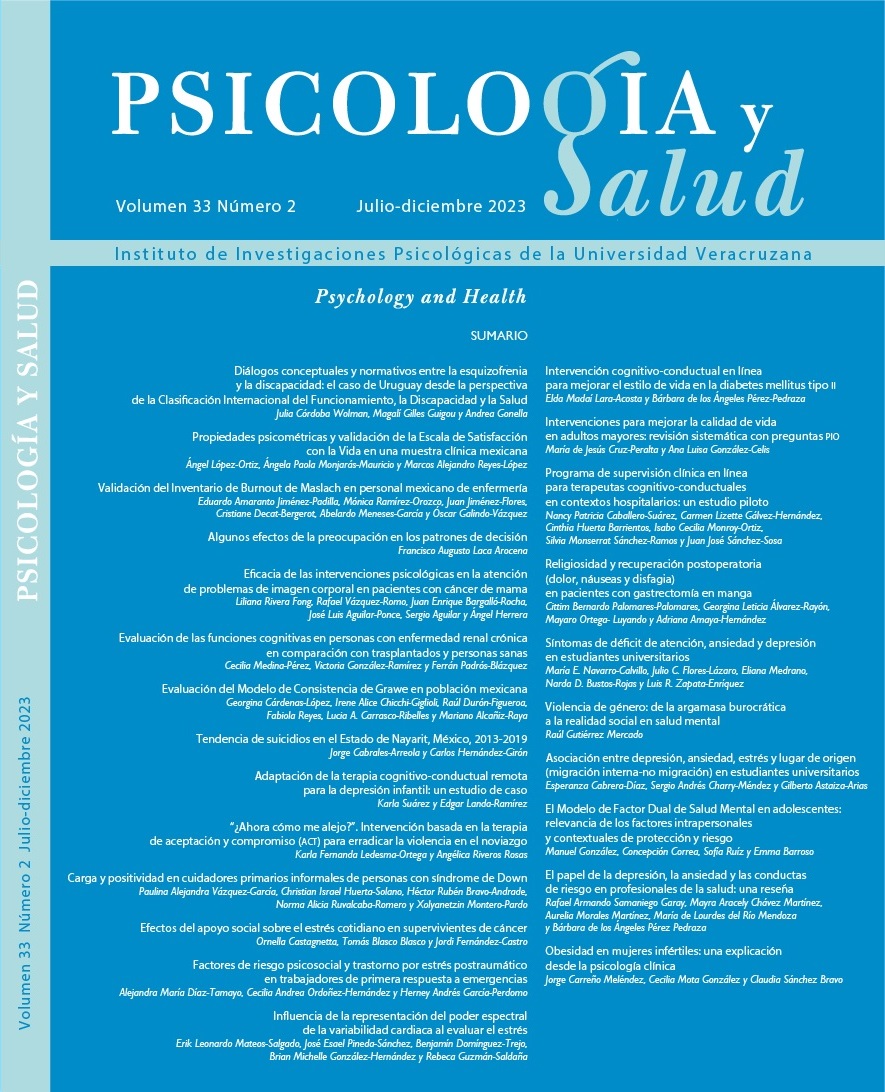Resumen
Los trastornos mentales representan una de las principales problemáticas sociales a nivel mundial, por lo que se han propuesto modelos teóricos para fundamentar intervenciones integradoras. El modelo de Consistencia de Grawe, plantea que existen cuatro necesidades básicas que requieren ser satisfechas para el mantenimiento de la salud mental. Estas se refieren al apego, autoestima, control o autoeficacia y la disminución del dolor e incremento del placer. A pesar de que existen algunos estudios que han analizado la relación entre estos constructos, existen pocos que se centran en la evaluación del modelo de Grawe. Por tanto, esta investigación tuvo como objetivo evaluar la relación existente entre las cuatro necesidades básicas en población mexicana. Se contó con un total de 61 participantes, de los cuales fueron 29 hombres y 31 mujeres, a los cuales se les administró una serie de escalas que miden los cuatro constructos mencionados. De manera general, los resultados mostraron correlaciones significativas en las distintas escalas y subescalas. El estudio permitió contar con una mayor comprensión en cuanto a las necesidades psicológicas básicas planteadas en el modelo de Grawe en población mexicana, sin embargo, se comentan algunas limitaciones y aspectos a considerar en trabajos futuros.
Citas
Ainsworth, M.D.S., Blehar, M.C., Waters, E. y Wall, S. (1978). Patterns of attachment: A psychological study of the Strange Situation. Lawrence Erlbaum.
Bandura, A. (1982). Self-efficacy mechanism in human agency. American Psychologist, 37(2), 122.
Bartholomew, K. y Horowitz, L.M. (1991). Attachment styles among young adults: a test of a four-category model. Journal of Personality and Social Psychology, 61(2), 226.
Bellón, J.A., Delgado, A., De Dios L, J. y Lardelli, P. (1996). Validez y fiabilidad del Cuestionario de Apoyo Social Funcional Duke-UNC-11. Atención Primaria, 18, 153-163.
Berking, M., Holtforth, M.G. y Jacobi, C. (2003). Changes in clinically relevant goals and therapy outcome: A study with inpatients undergoing cognitive behavioral therapy. Psychotherapie, Psychosomatik & Medizinsche Psychologie, 53(3), 171-177.
Bowlby, J. (1973). A secure base: Clinical applications of attachment theory (Collected papers). Tavistock.
Broadhead, W.E., Gehlbach, S.H., De Gruy, F.V. y Kaplan, B.H. (1988). The Duke–UNC Functional Social Support Questionnaire: Measurement of social support in family medicine patients. Medical Care, 26(7), 709-723. Doi: 10.1097/00005650-198807000-00006.
Carver, C.S. (1997). You want to measure coping but your protocol’too long?: Consider the Brief Cope. International journal of Behavioral Medicine, 4(1), 92.
Carver, C.S. y White, T.L. (1994). Behavioral inhibition, behavioral activation, and affective responses to impending reward and punishment: the BIS/BAS scales. Journal of Personality and Social Psychology, 67(2), 319.
Cassidy, J. (1990). Theoretical and methodological considerations in the study of attachment and the self in young children. En T. M. Greenberg, D. Cicchetti y M. Cummings (Eds.): Attachment in the preschool years: Theory, research, and intervention (pp. 87-119). Chicago University Press.
Chicchi-Giglioli, I.A., Pravettoni, G., Sutil M., D.L., Parra, E. y Alcañiz R., M. (2017). A novel integrating virtual reality approach for the assessment of the attachment behavioral system. Frontiers in Psychology, 8, 959. Doi: 10.3389/fpsyg.2017.00959.
Cooper, M.L., Shaver, P.R. y Collins, N.L. (1998). Attachment styles, emotion regulation, and adjustment in adolescence. Journal of Personality and Social Psychology, 74(5), 1380.
De León R., C.A. y García M., M. (2016). Escala de Rosenberg en población de adultos mayores. Ciencia Psicológica, 10(2), 119-127.
Elliot, A.J. y Covington, E.A. (2001). Approach and avoidance motivation. Educational Psychology Review, 13(2), 73-92. Doi: 10.1023/A:1009009018235.
Erdle, S. y Rushton, J.P. (2010). The general factor of personality, BIS–BAS, expectancies of reward and punishment, self-esteem, and positive and negative affect. Personality and Individual Differences, 48(6), 762-766.
Gorrese, A. y Ruggieri, R. (2013). Peer attachment and self-esteem: A meta-analytic review. Personality and Individual Differences, 55(5), 559-568.
Gratz, K.L. y Roemer, L. (2004). Multidimensional assessment of emotion regulation and dysregulation: Development, factor structure, and initial validation of the difficulties in emotion regulation scale. Journal of Psychopathology and Behavioral Assessment, 26(1), 41-54.
Grawe, K. (2004). Psychological therapy. Hogrefe Publishing.
Grawe, K. (2007). Neuropsychotherapy: How the neurosciences inform effective psychotherapy. Lawrence Erlbaum Associates Publishers.
Hervás, G. y Jódar, R. (2008). Adaptación al castellano de la Escala de Dificultades en la Regulación Emocional. Clínica y Salud, 19(2), 139-156.
King, L.A. y Emmons, R.A. (1990). Conflict over emotional expression: Psychological and physical correlates. Journal of Personality and Social Psychology, 58(5), 864.
Kogut, E. (2016). Adult attachment styles, self-efficacy, and causal attributional style for achievement-related failures. Learning and Individual Differences, 50, 64-72.
Kring, A.M., Smith, D.A. y Neale, J.M. (1994). Individual differences in dispositional expressiveness: Development and validation of the Emotional Expressivity Scale. Journal of Personality and Social Psychology, 66(5), 934.
Lane, J., Lane, A.M. y Kyprianou, A. (2004). Self-efficacy, self-esteem and their impact on academic performance. Social Behavior and Personality, 32(3), 247-256.
Melero, R. y Cantero, M.J. (2008). Los estilos afectivos en población española: un cuestionario de evaluación del apego adulto. Clínica y Salud, 19(1), 83-100.
Meyer, B., Olivier, L. y Roth, D.A. (2005). Please don’t leave me! BIS/BAS, attachment styles, and responses to a relationship threat. Personality and Individual Differences, 38(1), 151-162.
Mikulincer, M. y Shaver, P. (2005). Mental representations of attachment security: Theoretical foundation for a positive social psychology. En M. W. Baldwin (Ed.): Interpersonal cognition (pp. 233-266). The Guilford Press.
Mikulincer, M. y Shaver, P. R. (2012). An attachment perspective on psychopathology. World Psychiatry, 11(1), 11-15.
Piemontesi, S.E. (2012). The emotional expressivity scale validation in Argentine university students. Suma Psicológica, 19(1), 59-68.
Rojas B., C.A., Zegers P., B. y Förster M., C.E. (2009). La Escala de Autoestima de Rosenberg: validación para Chile en una muestra de jóvenes adultos, adultos y adultos mayores. Revista Médica de Chile, 137(6), 791-800. Doi: 10.4067/S0034-98872009000600009.
Rosenberg, M. (1965). Society and the adolescent self-image. Princeton. University Press.
Rotter, J.B. (1966). Generalized expectancies for internal versus external control of reinforcement. Psychological Monographs: General and Applied, 80(1), 1.
Schwarzer, R. y Jerusalem, M. (2010). The General Self-efficacy Scale (GSE). Anxiety, Stress, and Coping, 12(1), 329-345.
World Health Organization (2011). Global burden of disease. WHO Health Statistics and Health Information Systems. WHO.

